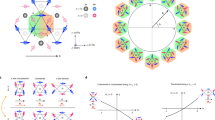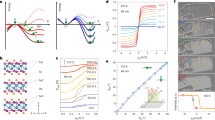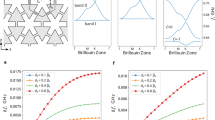Abstract
Strain engineering is widely used to manipulate the electronic and magnetic properties of complex materials. For example, the piezomagnetic effect provides an attractive route to control magnetism with strain. In this effect, the staggered spin structure of an antiferromagnet is decompensated by breaking the crystal field symmetry, which induces a ferrimagnetic polarization. Piezomagnetism is especially appealing because, unlike magnetostriction, it couples strain and magnetization at linear order, and allows for bi-directional control suitable for memory and spintronics applications. However, its use in functional devices has so far been hindered by the slow speed and large uniaxial strains required. Here we show that the essential features of piezomagnetism can be reproduced with optical phonons alone, which can be driven by light to large amplitudes without changing the volume and hence beyond the elastic limits of the material. We exploit nonlinear, three-phonon mixing to induce the desired crystal field distortions in the antiferromagnet CoF2. Through this effect, we generate a ferrimagnetic moment of 0.2 μB per unit cell, nearly three orders of magnitude larger than achieved with mechanical strain.
This is a preview of subscription content, access via your institution
Access options
Access Nature and 54 other Nature Portfolio journals
Get Nature+, our best-value online-access subscription
$29.99 / 30 days
cancel any time
Subscribe to this journal
Receive 12 print issues and online access
$209.00 per year
only $17.42 per issue
Buy this article
- Purchase on Springer Link
- Instant access to full article PDF
Prices may be subject to local taxes which are calculated during checkout






Similar content being viewed by others
Change history
15 February 2021
A Correction to this paper has been published: https://doi.org/10.1038/s41567-020-0977-7
References
Dzialoshinskii, I. E. The problem of piezomagnetism. Sov. Phys. JETP 6, 621–622 (1958).
Borovik-Romanov, A. S. Piezomagnetism, linear magnetostriction and magnetooptic effect. Ferroelectrics 162, 153–159 (1994).
Oelkrug, D. Absorption spectra and ligand field parameters of tetragonal 3d-transition metal fluorides. In Structure and Bonding Vol. 9, 1–26 (Springer, 1971).
O’Toole, N. J. & Streltsov, V. A. Synchrotron X-ray analysis of the electron density in CoF2 and ZnF2. Acta Crystallogr. B 57, 128–135 (2001).
Stout, J. W. & Matarrese, L. M. Magnetic anisotropy of the iron-group fluorides. Rev. Mod. Phys. 25, 338–343 (1953).
Erickson, R. A. Neutron diffraction studies of antiferromagnetism in manganous fluoride and some isomorphous compounds. Phys. Rev. 90, 779–785 (1953).
Borovik-Romanov, A. S. Piezomagnetism in the antiferromagnetic fluorides of cobalt and manganese. Sov. Phys. JETP 11, 786–793 (1960).
Moriya, T. Piezomagnetism in CoF2. J. Phys. Chem. Solids 11, 73–77 (1959).
Abrabam, A. & Pryce, M. H. L. The theory of paramagnetic resonance in hydrated cobalt salts. Proc. R. Soc. Lond. A 206, 173–191 (1997).
Figgis, B. N. & Lewis, J. in Progress in Inorganic Chemistry, Vol. 6 (ed. Cotton, F. A.) 37–239 (Wiley, 1964).
von Hoegen, A., Mankowsky, R., Fechner, M., Först, M. & Cavalleri, A. Probing the interatomic potential of solids with strong-field nonlinear phononics. Nature 555, 79–82 (2018).
Först, M. et al. Nonlinear phononics as an ultrafast route to lattice control. Nat. Phys. 7, 854–856 (2011).
Juraschek, D. M., Fechner, M. & Spaldin, N. A. Ultrafast structure switching through nonlinear phononics. Phys. Rev. Lett. 118, 054101 (2017).
Nova, T. F. et al. An effective magnetic field from optically driven phonons. Nat. Phys. 13, 132–136 (2016).
Mankowsky, R. et al. Nonlinear lattice dynamics as a basis for enhanced superconductivity in YBa2Cu3O6.5. Nature 516, 71–73 (2014).
Nova, T. F., Disa, A. S., Fechner, M. & Cavalleri, A. Metastable ferroelectricity in optically strained SrTiO3. Science 364, 1075–1079 (2019).
Radaelli, P. G. Breaking symmetry with light: ultrafast ferroelectricity and magnetism from three-phonon coupling. Phys. Rev. B 97, 085145 (2018).
Liu, B. et al. Generation of narrowband, high-intensity, carrier-envelope phase-stable pulses tunable between 4 and 18 THz. Opt. Lett. 42, 129–131 (2016).
Balkanski, M., Moch, P. & Parisot, G. Infrared lattice‐vibration spectra in NiF2, CoF2, and FeF2. J. Chem. Phys. 44, 940–944 (1966).
Giordano, J. & Benoit, C. Infrared spectra of iron, zinc and magnesium fluorides. I. Analysis of results. J. Phys. C 21, 2749–2770 (1988).
Wong, Y. H., Scarpace, F. L., Pfeifer, C. D. & Yen, W. M. Circular and magnetic circular dichroism of some simple antiferromagnetic fluorides. Phys. Rev. B 9, 3086–3096 (1974).
Kharchenko, N., Mil’ner, A., Eremenko, V. & Bibik, A. Magnetic circular dichroism in antiferromagnetic cobalt fluoride. Zh. Eksp. Teor. Fiz. 94, 340–349 (1988).
Gaydamak, T. N. et al. Acoustopiezomagnetism and the elastic moduli of CoF2. Low. Temp. Phys. 40, 524–530 (2014).
Kharchenko, N. F. The linear magneto-optic effect as a manifestation of a higher order magnetoelectric effect. Ferroelectrics 162, 173–189 (1994).
Bolz, R. E. CRC Handbook of Tables for Applied Engineering Science 2nd edn (CRC, 1973).
Kimel, A. V. et al. Inertia-driven spin switching in antiferromagnets. Nat. Phys. 5, 727–731 (2009).
Maehrlein, S. F. et al. Dissecting spin-phonon equilibration in ferrimagnetic insulators by ultrafast lattice excitation. Sci. Adv. 4, eaar5164 (2018).
Atxitia, U., Nieves, P. & Chubykalo-Fesenko, O. Landau–Lifshitz–Bloch equation for ferrimagnetic materials. Phys. Rev. B 86, 104414 (2012).
Atxitia, U., Hinzke, D. & Nowak, U. Fundamentals and applications of the Landau–Lifshitz–Bloch equation. J. Phys. D 50, 033003 (2017).
Song, C. et al. How to manipulate magnetic states of antiferromagnets. Nanotechnology 29, 112001 (2018).
Baltz, V. et al. Antiferromagnetic spintronics. Rev. Mod. Phys. 90, 015005 (2018).
Liu, Z. et al. Antiferromagnetic piezospintronics. Adv. Electron. Mater. 5, 1900176 (2019).
Chu, J. H., Kuo, H. H., Analytis, J. G. & Fisher, I. R. Divergent nematic susceptibility in an iron arsenide superconductor. Science 337, 710–712 (2012).
Hicks, C. W. et al. Strong increase of Tc of Sr2RuO4 under both tensile and compressive strain. Science 344, 283–285 (2014).
Kirilyuk, A., Kimel, A. V. & Rasing, T. Ultrafast optical manipulation of magnetic order. Rev. Mod. Phys. 82, 2731–2784 (2010).
Juraschek, D. M., Fechner, M., Balatsky, A. V. & Spaldin, N. A. Dynamical multiferroicity. Phys. Rev. Mater. 1, 014401 (2017).
Baruchel, J., Schlenker, M. & Barbara, B. 180° antiferromagnetic domains in MnF2 by neutron topography. J. Magn. Magn. Mater. 15–18, 1510–1512 (1980).
Van Der Ziel, J. P. & Guggenheim, H. J. Optical spectrum of CoF2. Phys. Rev. 166, 479–487 (1968).
Zimring, L. J. & Stout, J. W. Polarized crystal spectra of CoF2 and Co0.06Zn0.94F2. J. Chem. Phys. 51, 4197–4209 (1969).
Acknowledgements
We thank J. Chen for help preparing the samples and assistance with the optical experiment. This work received funding from the European Research Council under the European Union’s Seventh Framework Programme (FP7/2007–2013)/ERC (grant agreement no. 319286 (QMAC)) and the Cluster of Excellence ‘CUI: Advanced Imaging of Matter’ of the Deutsche Forschungsgemeinschaft (DFG), EXC 2056, project ID 390715994. Work done at the University of Oxford was funded by EPSRC grant no. EP/M020517/1, entitled Oxford Quantum Materials Platform Grant. A.S.D. was supported by a fellowship from the Alexander von Humboldt Foundation.
Author information
Authors and Affiliations
Contributions
P.G.R. and A.C. planned the project together with A.S.D. and M. Först. A.S.D. designed and performed the experiments with help from B.L., T.F.N. and M. Först. A.S.D. analysed the experimental data. M. Fechner carried out the first-principles calculations. M. Fechner, A.S.D. and P.G.R. developed the phenomenological model. D.P. prepared the samples. A.S.D. and A.C. wrote the manuscript with feedback from all co-authors.
Corresponding authors
Ethics declarations
Competing interests
The authors declare no competing interests.
Additional information
Publisher’s note Springer Nature remains neutral with regard to jurisdictional claims in published maps and institutional affiliations.
Supplementary information
Supplementary Information
Supplementary Information, Figs. 1–6, Tables 1–3 and refs. 1–25.
Source data
Source Data Fig. 4
Data for measured Faraday rotation and circular dichroism plotted in Fig. 4.
Source Data Fig. 5
Data for measured temperature, field and frequency dependences plotted in Fig. 5.
Source Data Fig. 6
Data for induced magnetization from experiment and theory plotted in Fig. 6.
Rights and permissions
About this article
Cite this article
Disa, A.S., Fechner, M., Nova, T.F. et al. Polarizing an antiferromagnet by optical engineering of the crystal field. Nat. Phys. 16, 937–941 (2020). https://doi.org/10.1038/s41567-020-0936-3
Received:
Accepted:
Published:
Issue Date:
DOI: https://doi.org/10.1038/s41567-020-0936-3
This article is cited by
-
Three-stage ultrafast demagnetization dynamics in a monolayer ferromagnet
Nature Communications (2024)
-
Phononic switching of magnetization by the ultrafast Barnett effect
Nature (2024)
-
Terahertz electric-field-driven dynamical multiferroicity in SrTiO3
Nature (2024)
-
Terahertz field-induced nonlinear coupling of two magnon modes in an antiferromagnet
Nature Physics (2024)
-
Terahertz-field-driven magnon upconversion in an antiferromagnet
Nature Physics (2024)



